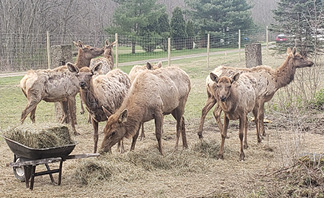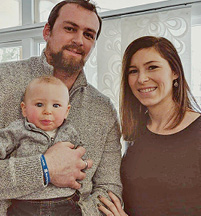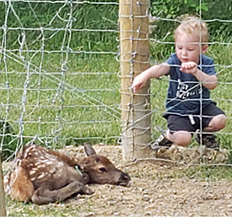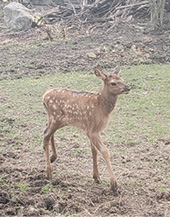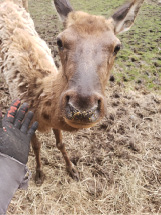Emerald Grove Farm introduces elk to Hinckley
by Erica Peterson
Curtis Bordwell has had so many people pulling into his River Road driveway to get a closer look at the animals on his farm, he had to put up “No Trespassing” signs.
“During the pandemic, someone was so interested, but didn’t want to get out of their vehicle, that they laid on the horn until I came out and then yelled, ‘What’s that in the pasture?’” he said.
“That” is elk. Bordwell is one of only a handful of people raising them in Ohio and believes his Emerald Grove Farm is the only elk farm in Medina County.
Bordwell, and his wife, Rachel, are raising the elk on part of the former Robb family farm. They moved to Hinckley from Copley in December and have two children: son Ronan, 2, and infant daughter Faelan.
“It’s pretty much the ideal location for us,” Bordwell said, referring to the 7 acres of space and the fact that it’s in the Highland Local School District.
“We always wanted a farm property,” Bordwell said, but a small, “low-key” operation with a few animals, so they could have their kids grow up with a farm life.
They were attracted to the house and 124-year-old barn on property that is surrounded by homes owned by members of the Robb family.
Bordwell’s neighbor John Robb showed him a photo of the original barn-raising in 1896.
“It’s the best-condition farm for that age I’ve ever seen,” he said.
The Robbs have deep roots in Hinckley. Walter A. Robb Sr. moved to River Road in 1922 and raised his four sons: Richard, Ramon, Herbert and Walter Jr.
Walter Sr. was a charter member of the Hinckley Fire Department, he first township zoning inspector, and, in 1942, was elected a Hinckley Township Trustee for two terms.
Walter Jr. was a member of the Hinckley Zoning Board for eight years and in 1994, was elected township trustee for two terms. He helped create the Hinckley Township flag, the first township flag in the state of Ohio, as well as Hinckley Veterans Memorial Park.
The Robb property seemed too good to pass up, Bordwell said.
“It just seems like a waste to have a barn and a property this big and not have a farm,” he said.
Bordwell works full time as a molecular biologist in Cleveland, so he wanted to raise an animal that wouldn’t need a lot of space or attention. Elk filled the bill.
“They’re very self-sufficient,” he said. “They are grazers, plus they eat hay. You can fit more elk per acre than cow, and they are not as ‘needy’ as something like a horse. Plus, you can domesticate them fairly easily.”
Some of the elk are already eating out of his hand, he said, and allow him to pet them.
Bordwell bought eight elk to start, knowing that some of them were pregnant. He’s up to 11 now, and he expects a few more calves.
Every morning starts with a walk around the pasture to see if there are any new additions. He was alerted to the birth of one of the elk by his neighbor.
Bordwell monitors the calves closely for the first week or so. It’s a balance between getting the elk comfortable around humans and respecting that they are wild animals that can grow up to 700 pounds.
“They are super peaceful, but when I was visiting elk farms before I started mine, I saw a 1,000-pound bull pick up another one with its antlers,” he said.
To make sure they are safely penned in, Bordwell installed 8-foot-high, high-tensile fencing around the pasture. “These are giant animals that can jump 7 feet,” he said.
He plans to harvest a few elk for meat in the fall or winter, when he’s sure all the calves are fully weaned.
“Elk is delicious,” he said. “And this is as local as it gets.”
Normally, one elk can produce 120-150 pounds of meat. He’s taking preorders via Facebook.
“We’re a very small operation and raising them organically and naturally, so our supply will obviously be rather limited,” Bordwell said.
The animals produce more than meat.
“The No. 1 market for elk is the antler velvet,” Bordwell says. “It sells for crazy money.”
The velvet is popular in Eastern medicine, he said. Some farms out West focus on velvet more than meat, he said.
Elk shed their antlers every year and grow a new set, so velvet can be harvested then. Antlers can also be cut, which farmers might want to do, especially during mating season, Bordwell said.
Their antlers are among the fastest-growing tissue in the animal kingdom, growing up to an inch a day.
There is also a market for the antlers themselves, as they are popular as chew bones for dogs. Some Hinckley dog owners have already asked about the antlers via social media, Bordwell said.
A wildlife officer also told him that there is a market for elk fur. They shed their coat every year, making them look a little scruffy in the spring, Bordwell said.
“The friendliest of my elk let me pluck out tufts of their winter coat,” he said.
Ideally, he would like to keep five to seven elk on the farm. He has all females now, but one of the calves is a male who will be ready to breed in two years. He will probably bring in another male, to deepen the gene pool.
If he does, nearby residents will know. During mating season, bulls have an unmistakable bugle.
“The females have sort of a squeak, but the males? They have a roar,” Bordwell said.
He is looking forward to establishing the elk farm on the former Robb property.
“It hasn’t been a farm in a half a century,” Bordwell said. “It was a sheep farm, then a Christmas tree farm. To bring that back to life, and to use the barn for animals, has been gratifying.” For more information about Emerald Grove Farm, contact Bordwell at EmeraldElkVenison@gmail.com.
Feature image photo caption: Curtis and Rachel Bordwell are raising elk on their Emerald Grove Farm, the first elk farm in Hinckley Township and one of only a few in the state. Photo courtesy Curtis Bordwell.
